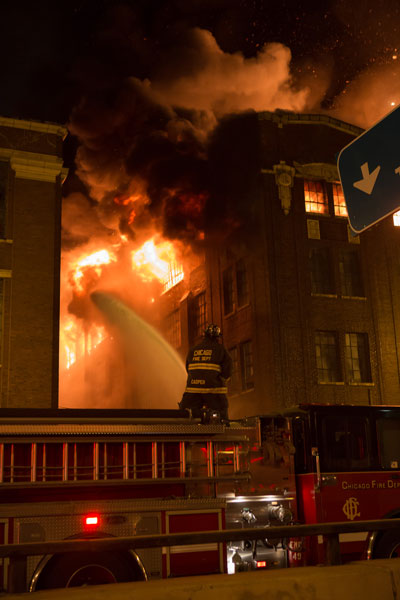
By Frank Ricci, Sean Gray, P.J. Norwood, Chris Pepler, Howard Blthye, Brandon DeMars, Jay Balletto, Anthony Avillo
This covers the main conversation from a recent episode of the radio show “Politics & Tactics.”
With the new focus on science in the fire service, we would like to start the conversation of proper stream placement and master stream strategy for structural firefighting. The National Institute of Standards and Technology (NIST) and Underwriters Laboratories (UL) should play a lead role in reconciling tactics we present in this article. Our recommendations are based off of experience and the hope of achieving the best possible outcomes. However, although experience is the best teacher, only a fool learns in this school alone. We want to hear from you and we would hope that with future funding NIST and UL could put these recommendations to the test.
Point of Application
Sean Gray’s FDIC 2014 class, “Attack from the BURNED side,” showed some convincing film clips about having stream discipline. The clip that had the most impact was a firefighter on an exterior handline. He was moving the line back and forth hitting the fire venting out multiple windows onto a porch. The firefighter played the stream back and forth racking the windows and ceiling of the porch. It was clear he was only chasing the ignited fire gases and was making no impact on the seat of the fire.
Recommendation: When playing a stream through a window venting fire, place the stream in one window and keep steady in that window until you witness a significant change in the conditions, then move to the next window and repeat. Whipping a solid stream around or using a fog stream is less effective in achieving the reach and penetration necessary to get to the seat of the fire. It’s important to use solid or straight streams only from the exterior. Authors’ note: our next blog will explore this issue in depth.
Apparatus Positioning
Properly positioning the aerial device is the first step in placing an elevated master stream in the position of most effectiveness. Engine drivers may unknowingly block the truck from its desired position. Cross-training and discipline are issues that should be incorporated into your department’s training program. Timely radio transmission from the aerial operator is critical, because once hoselines begin to touch the ground, your chance of having that engine move are somewhere between slim and none. Engine drivers must realize at large fires that giving the truck the address may not be enough, especially if your tower apparatus is the second-due truck.
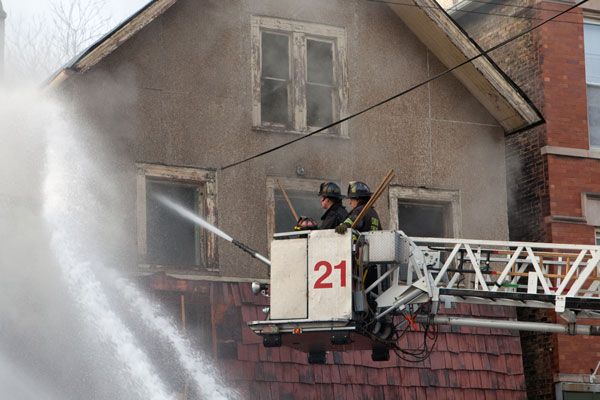
Stream Placement
There is no one-size-fits-all solution. It appears to be more effective at directing the stream upward through a window then placing water through the roof (figure 1). If after the roof burns through and your stream starts to appear in the air, the tower can reposition to play the stream from above. Another strategy that becomes a factor before collapse is to breach the side of the cockloft and play water across the attic. It is critical to realize that the portion of the roof that is still intact cannot discriminate between ladder pipe water and rain!
Recommendation: Play the stream low on an upward angle through a window before moving above.
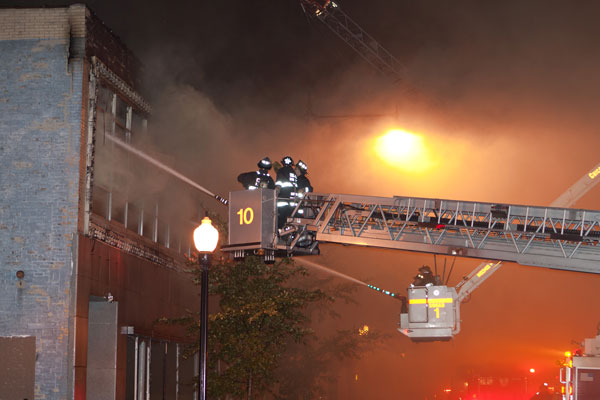
Photo by Steve Redick
Multiple Floors On Fire
When dealing with multiple floors on fire, what is the best practice? Some old salts advocate for working from top floors down. The newer practice of working from the bottom up is now growing in popularity, and the authors have witnessed the effectiveness of going from the bottom up. Firefighters were all taught not to pass fire, and we believe it may apply here. Extinguishing the lower floor first stops fire propagation upward and allows expanding stream to absorb more heat.
Recommendation: For multiple floors on fire, start low and move high.
Attic Fires
When dealing with a residential attic fire, the common tactic is to get in, pull or hook as much of the top floor sheetrock, and flow as much water as you can. However, opening up the walls this much is a practice firefighters must move away from. Ventilation is creating a hole to allow heat and gases out, but it also allows air in. Opening the attic in this manner allows for rapid fire growth. If the fire is not venting through the roof, there may be unnecessary damage to the interior of the residence. A master stream can be placed so that lateral water dispersion will play into that attic space from the exterior. If a gable vent or soffit attack is unavailable, think about finding a space on the interior that has a narrow distance between walls to eliminate a collapse hazard such as a bathroom or a narrow hallway. Too often we go into the largest rooms and start-pulling ceiling. This is not the best practice and causes a large amount of damage to the interior.
Recommendation: Start from the outside by flowing water into the soffit and rake the eaves from one end of the structure to the other. Another option is to attack with a tower through the gable vent for a quick application of water. If you need to fight from the inside, use small focused holes. Both tactics will still require you to get up in the attic to complete extinguishment.
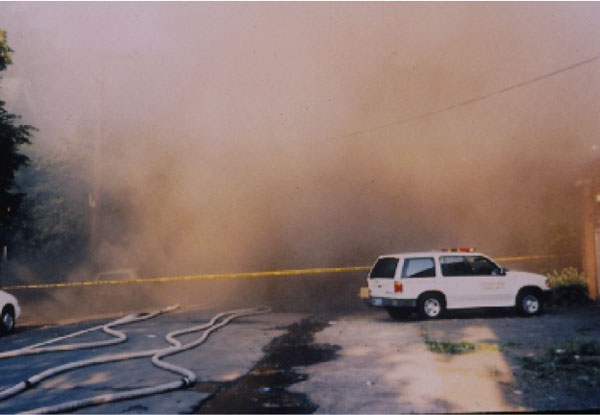
Photo courtesy New Haven (CT) Fire Fighters.
Zero Visibility in the Street
It is not uncommon to be working at a large fire during the summer and find smoke blanketing the street hindering visibility and apparatus and master stream placement. One tactic at a total loss is to protect exposures and shut down master stream operations. This will allow the fire to grow, drawing it out and lifting the smoke in the street. Take this opportunity to position additional tower apparatus and elevated streams on rooftops and in flanking positions. In other words, draw the fire out, surround the building, and then open up and kill the fire. This tactic should only be used once. We used this at a recent three-alarm fire in New Haven, Connecticut. Battalion Chief Jooss commented when we were critiquing the operation that several master streams should be kept flowing and placed in a position such that they will have no impact on the fire. In hindsight, the authors could not agree more. This is for public relations so it does not appear that the fire department had a loss of water.

Photo by Leon Brown. A homemade alteration resulting in water emitting out of bolt holes.
Homemade Modifications to Master Streams
While the sales staff of a company may look the other way, the engineers and the lawyers will not. Removing hand wheels and especially safety pins that prevent the stream from being moved into a position that can overload the ladder will place firefighters at greater risk of injury or death. Modifications to the deck guns can result in failure as well as voiding the warranty on your ladder. Yes, firefighters want to be able to move the stream quickly, however it is the officer’s responsibility to ensure firefighter safety. It has been long said that when the tower goes up, the building comes down. What is the rush at a total loss taking a few extra seconds to move the ladder to get the right angle? This action will not make or break the operation. A deck gun that can move freely when someone’s hand comes off it is dangerous. In the 1980s, New Haven had a master stream inadvertently strike the tip of a ladder, causing the entire ladder to fail while a firefighter was climbing it to make a rescue.
Organizing for Success and Safety
Using master streams in a defensive strategic mode often requires operations to be conducted on several fronts. When exposures are threatened (no matter on what side), streams must be in place to not only protect those exposures, but also if possible, apply water to the parent body of fire, diminishing the heat output (which is creating the exposure threat in the first place.) As an incident commander, it is your responsibility to ensure that the intended actions of your elevated streams around the fireground are having the desired effect. Do NOT take it upon yourself to run laps around the fireground in an attempt to get this information firsthand. It is fruitless and causes a disorganization of your organization.
As this is undoubtedly a multiple-alarm fire, you should have multiple layers of supervision to address all the areas of operation out of the direct control and eyeshot of the command post. All additional alarm response protocols must have a built-in provision that sends a chief officer (or two) with the compliment of the companies responding. In fact, each successive alarm must bring an additional chief. All major areas of operation must have a division supervisor assigned who monitors, evaluates, and reports to command the situation status and accountability profile of his assigned division. This will keep the IC grounded at the command post where he or she belongs. Without these layers of supervision, command will be overwhelmed and command nothing.
Another piece of the supervisory pie when the master streams begin deluging the fire building is a water supply officer. Get out the hydrant grid maps and forecast where your additional water supplies will come from. Do not wait until water is being stolen from one division to the next. Plan early, bring in the big water from remote mains if you have to (use manifolds for this) and do not get caught short on the water supply issue. That is just as much a function of command as breaking down the fireground is.
One last thing: Command MUST command. Command has no business touching hose, raising ladders, breaking windows or any other touchy-feely firefighting activities. Run the fire…that’s enough!
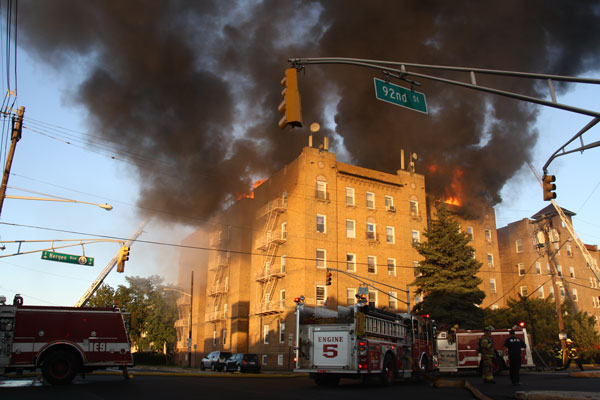
Photo by Ron Jeffers
This multiple dwelling fire on the North Hudson/Bergen County (NJ) border started in the cockloft and required five alarms, extensive mutual aid (and decentralization of command) and six water supplies, some consisting of multiple engine relays into Bergen County. Hydrant maps were extremely valuable in planning for the eventual use of five master streams. Chief officers assigned as division commanders were placed at strategic areas around the structure to assist in the management of this large footprint fireground.
Collapse Zones
When the determination is made to use master streams, all personnel should be prepared for a possible collapse. Consider the reason why you are setting up master streams. If the building is being overwhelmed by the fire, the added weight of water from the master streams could enhance the possibilities for a collapse. All personnel must be able to identify the indicators of a collapse and position themselves and their apparatus away from the building at least 1.5 times the height of the building. Some indicators to be aware of are:
- Loose bricks or stones
- Deteriorating mortar
- Walls leaning
- Noises from structural movement
- Cracks appearing in exterior walls
Depending on the conditions of the building, the IC can expand the collapse zone for better safety of the firefighters working. They may also direct firefighters to work in a flanking position to keep them away from the possible collapse.
Once the collapse zone is determined, some kind of indicator should be displayed showing where the zone is. Battalion Chief Billy Gould brought to our attention the red tape method. He said, “We should utilize red scene tape instead of yellow for collapse zones and where wires my drop.” A great idea: yellow means caution and red is stop. This tactic can be bolstered by assigning personal with the only task of maintaining the danger zone.
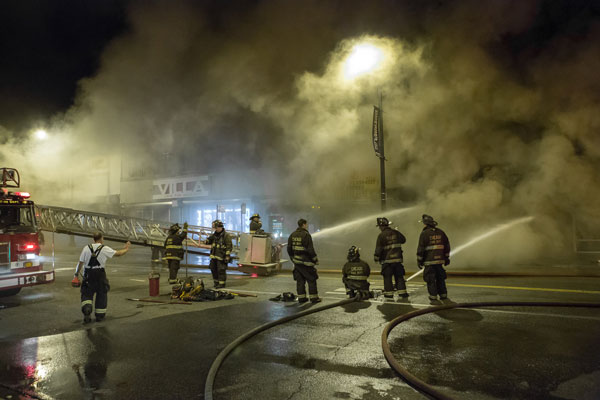
Photo by Steve Redick
Large Handlines
2.5-inch hoselines are extremely effective for quickly protecting an exposure, providing a quick knockdown, or providing an elevated stream from an exposure roof. However, for incidents of long duration, their use should be minimized in favor of tower streams, portable deck guns, and engine-mounted deck guns. This transition–along with proper rehab–reduces firefighter fatigue and the chance for needless injuries.
Firefighter Rehab
Proper rehabilitation should be conducted at every working fire. An EMS supervisor should be tasked to establish an EMS division or sector. Ambulances should be staged facing out of the incident. The EMS division should work with command or operations to ensure crews are rotated through and, at a minimum, personnel should be evaluated for heat stress, smoke inhalation, and elevated blood pressure. Rehabilitation is an assignment and accountability is critical. If your company is told to report to rehab, the entire company should then report. If any firefighter or member of the public is transported, the EMS division chief should have a written record of who was transported, injuries, and the hospital they were sent. This information should be relayed to operations of command.
On-Scene Critique
At any working fire, rescue or complex incident company officers should report to the command post to conduct an after-action review. This usually only takes 10 minutes and should occur before equipment has been picked up. This is not a rock-throwing session, rather it is designed to give a global view and improve future operation. Remember, officers have to make almost perfect decisions based off imperfect information. If you’re the officer running the critique, start off by stating what you would change or what you learned based off your actions. Honesty, self-reflection, and humility are hallmarks of a good leader. Your self-assessment will break down barriers and foster an environment of understanding and learning. Too many departments would rather please and conceal actions that will then be repeated in the future. However, we owe it to the public and our members to evaluate and correct in a non-punitive way to prepare for our next response.
For more information on master stream operations, check out our last radio show:
http://www.blogtalkradio.com/fireengineeringtalkradio/2014/09/01/episode-858-politics-and-tactics
FRANK RICCI is a contributing writer and educational advisory board member for Fire Engineering. He is the drillmaster for the New Haven (CT) Fire Department. He cohosts the radio show “Politics & Tactics. He was a contributing author to Fire Engineering’s Handbook for Firefighter I and II and the lead author for the Tactical Perspectives DVD series. He has been the lead consultant for several Yale studies. He won a landmark case before the U.S. Supreme Court.
SEAN GRAY is a 21-year veteran of the fire service and a lieutenant in the Cobb County (GA) Fire Department. He has a bachelor’s degree in fire safety engineering and is an advisory board member for the UL Firefighter Safety Research Institute.
P.J. NORWOOD is a deputy chief training officer for the East Haven (CT) Fire Department and has served four years with the Connecticut Army National Guard. He has authored “Dispatch, Handling the Mayday” (Fire Engineering Books and Videos, 2012); coauthored “Tactical Perspectives of Ventilation” and “Mayday” DVDs (2011, 2012); and he was a key contributor to the “Tactical Perspectives” DVD series. He is a Fire Engineering University faculty member, co-creator of Fire Engineering’s weekly video blog “The Job,” and host of a Fire Engineering Blog Talk Radio show. He is certified to the instructor II, officer III, and paramedic levels.
CHRIS PEPLER is deputy chief of the Torrington (CT) Fire Department.
G. HOWARD BLYTHE is a 14-year veteran of the Fire Department of New York, where he is a firefighter assigned to Ladder Company 27 in the Bronx. Previously, he was assigned to Ladder Company 15 and Ladder Company 113. A graduate of John Jay College in New York City and Oklahoma State University in Stillwater, he has a BA degree and an MS degree. He is a nationally certified fire instructor III and fire officer IV. He is an adjunct instructor for the Connecticut Fire Academy.
ANTHONY AVILLO, a 29-year veteran of the fire service, is a deputy chief in North Hudson (NJ) Regional Fire & Rescue, assigned as 1st Platoon regional tour commander. He has a BS degree in fire science and instructs at NJ College University and the Monmouth County (NJ) Fire Academy. He authored Fireground Strategies, 2nd edition (Fire Engineering, 2008) and Fireground Strategies Workbook Volumes I & II (Fire Engineering, 2002, 2010); contributed to Fire Engineering’s Handbook for Firefighter I and Firefighter II (Fire Engineering, 2009); coauthored its Study Guide (Fire Engineering, 2010); collaborated in the Tactical Perspectives DVD series (Fire Engineering, 2011); and issued the DVD Forging a Culture of Safety (Fire Engineering, 2013). He was the recipient of the 2012 Fire Engineering/ISFSI George D. Post Instructor of the Year Award.
JASON BALLETTO is a 17-year veteran of the New Haven (CT) Fire Department. He has been recently promoted as the Assistant Drillmaster of the New Haven Training Academy. He is also an instructor for the Connecticut Fire Academy and Middlesex Regional Fire School.

